Orange Mold
What is orange mold?
Orange mold is a common and a general name that we give to small, filamentous fungi and fungi-like organisms which are mostly seen growing in dark, moist places, but also on deadwood, forest soil, conifer cones, and foods (Fig. 1).
Generally, molds are saprophytic organisms, meaning that they feed on decaying organic matter. This is an extremely important role in any ecosystem, making molds and most fungi one of the supporting pillars of the entire biosphere. In fact, fungi (including orange molds) are the only organisms that can degrade lignocellulosic material.
All plants, especially trees, are made of sugars cellulose and hemicellulose encased in lignin. This structure gives strength and rigidity to plants while keeping water and herbivores away from the sugars. This also entails those fungi are the only organisms capable of breaking down lignin and making the sugars available for digestion. As lignocellulose makes the most abundant organic material on the planet, without saprophytes the world would soon become uninhabitable due to plant debris.
Concerned About Orange Mold? Get a Free Inspection!
Orange mold can pose hidden hazards in your home, often found in damp areas and posing health risks. Don’t let it go unchecked! Contact Mold Busters for a free virtual mold inspection. Our experts will provide a comprehensive assessment and a plan to tackle any mold issues, ensuring your home is safe and healthy. Act now to protect your space!
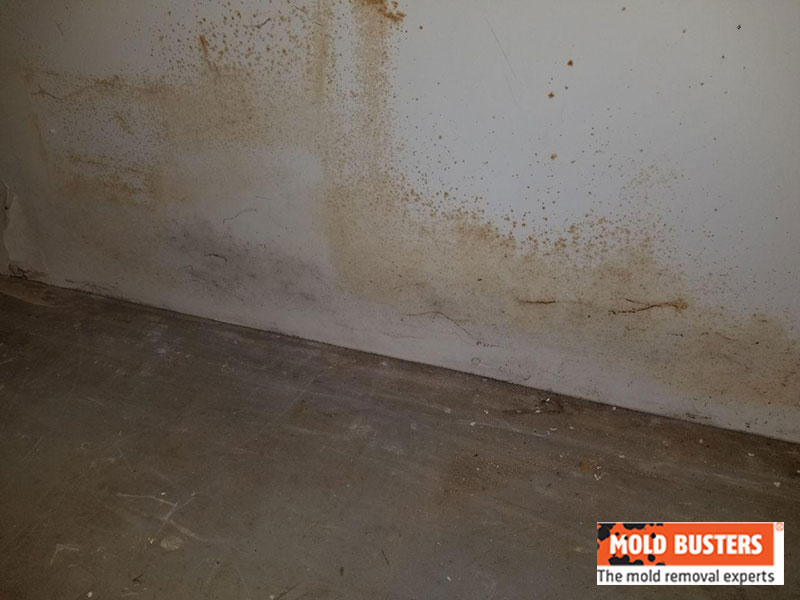
Types of orange mold
What we colloquially call orange molds encompasses two similar-looking groups of organisms, but morphologically, physiologically, and genetically very divergent. On one side, “common” molds are usually small-sized, filamentous fungi, which are predominantly saprophytic or plant pathogens, and can be opportunistic animal pathogens.
Their ecology is to colonize a substrate, extract the required nutrients, and when the time comes, produce and release spores. These spores are then released into the air, or spread via rain in hope of finding a suitable area or host to germinate and develop (Fig. 2). Fungi spores can also be spread via living vectors, such as insects and animals. Importantly, these spores are passive and cannot travel by themselves.
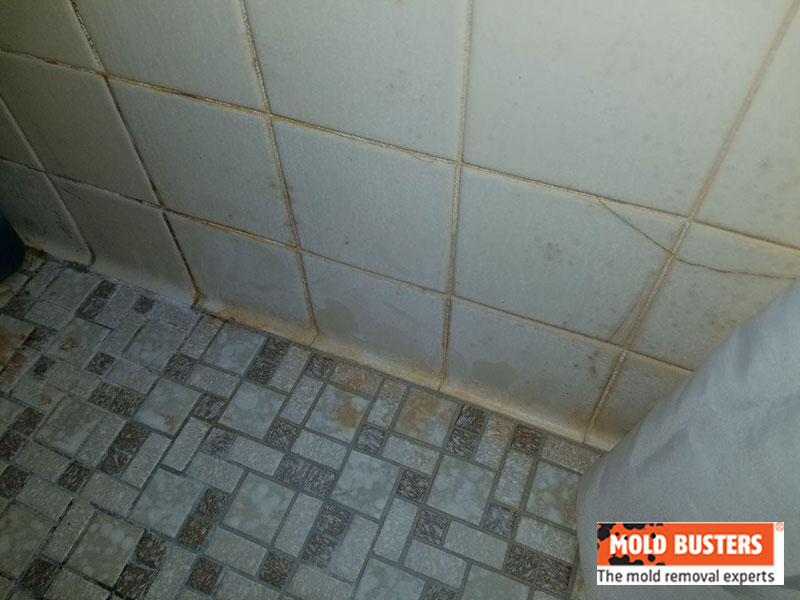
The other group of organisms that are often referred to as molds is, in fact, slime molds (Myxomycetes)- fungi-like organisms, which belong to the kingdom of Protista. Protists are a group of ancient organisms, which are not animals, plants, or fungi. As a result, they are diverse and can appear very different from each other. They include organisms such as primitive algae, amoeba, and slime molds. Slime molds spend most of their time as single-celled, motile organisms, and converge into the group form mostly for reproductive purposes.
Additionally, the kingdom of Fungi is full of various-shaped species with an even richer plethora of colors. Many of these species, such as Aleuria aurantia (the orange peel mushroom), Calocera viscosa, or the Laetiporus sulphureus (the chicken of the woods) are saprophytic and can somewhat resemble molds at their earliest wwws of development (Fig. 3).
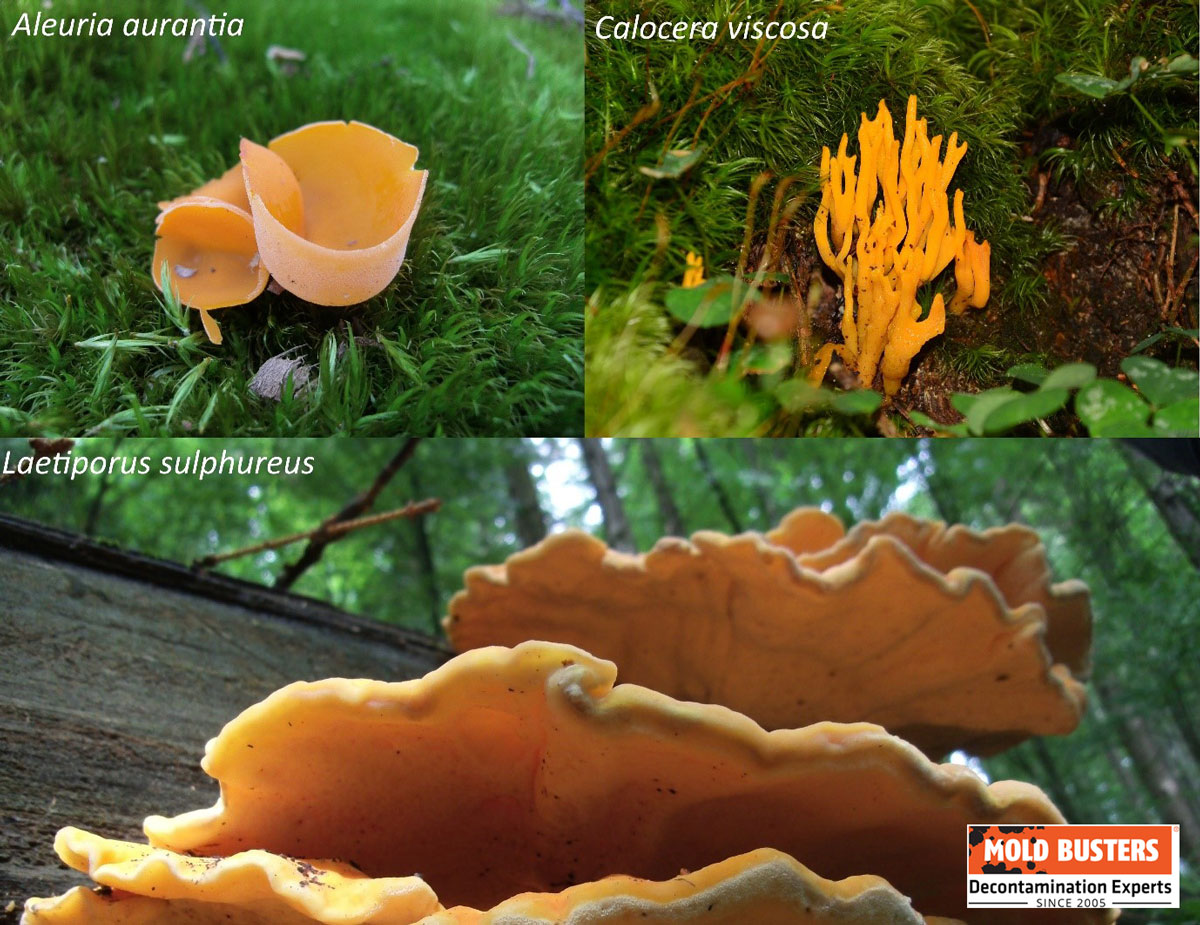
The true orange mold
Acremonium strictum
Acremonium strictum belongs to a group of saprophytic and opportunistic molds which causes hyalohyphomycosis – invasive infections by fungi without dark pigments. It is also pathogenic to many, and endophytic with some plant species. It is a widespread fungus found in soil, plant debris, and rotting mushrooms. The colonies formed by A. strictum can be orange, pink, yellow, and thusly is sometimes referred to as “orange mold”. Indoors, A. strictum is often found on moist, cellulose-based construction materials characterized by predominantly humid conditions.
Acremonium strictum caused human infections are rare, though occur as a wound infection or in immunocompromised individuals. A. strictum infecting individuals with weakened immunity, may result in invasive infections of lungs, bones, heart, brain membranes, and sepsis (1–3).
Epicoccum nigrum
Epicoccum nigrum is an asexual, pigment-producing saprophytic fungus, which can infect plants, and cause allergies in humans. E. nigrum can also appear on other fungi. It produces a variety of biomedically and industrially important molecules, including carotenoid pigments (yellow, red, and orange colors) (Fig. 4) (4).
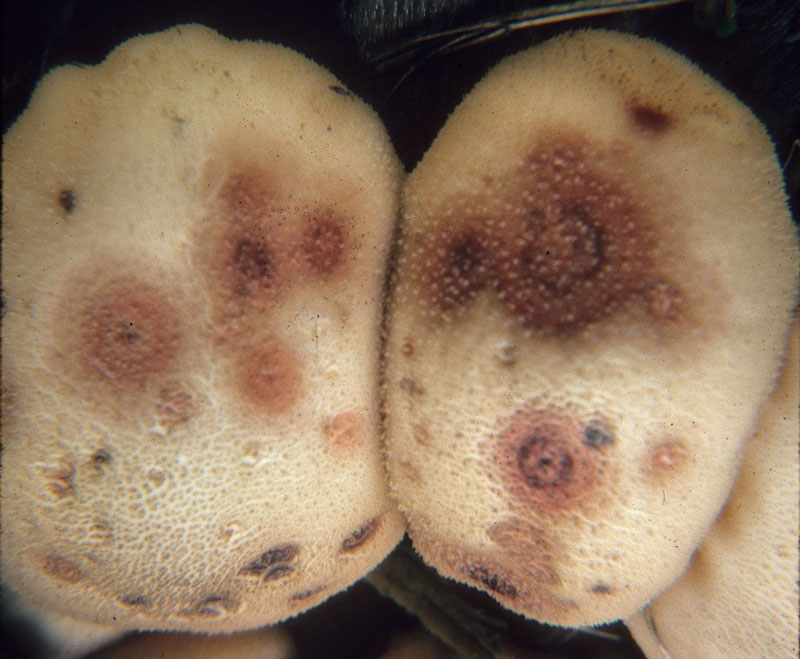
E. nigrum is also an epiphytic organism with the potential for biocontrol of certain pathogens of crop plants. Epiphytic fungi can infiltrate certain plant parts and inhabit them without causing infection. In this state, it displays antagonism against other fungi and can be used against Sclerotinia sclerotiorum in sunflowers, Pythium sp. in cotton, etc… (5–7).
E. nigrum can also contribute to various adverse health effects associated with indoor air quality, especially allergic reactions caused by inhalation. It is a significant outdoor and indoor allergen in urban communities and industrial complexes (8–10). Type III hypersensitivity pneumonitis (antigen-antibody complexes deposit in the blood and induce inflammation and tissue damage) due to E. nigrum has been reported in a case of indoor exposure, where two young children exposed to an unventilated basement shower developed a serologically confirmed E. nigrum hypersensitivity pneumonitis (11).
Aspergillus
Aspergillus molds are amongst the most widespread mold species, globally. They can reproduce at elevated temperatures and low water availability, which makes them one of the most widespread agents of spoilage in the world. However, their global presence and their success at colonizing various substrates make them hazardous to our health, because statistics show that they are one of the most frequently found indoor mold species (Fig. 5).

Aspergillus flavus
Aspergillus flavus colonies can sometimes appear orange-yellow. This mold is most certainly unsafe to have in the household as it is one of the several mycotoxin-producing aspergilli. These toxins, especially aflatoxin B1 and B2 can cause acute liver damage, liver cirrhosis, and are known for their immunosuppressive and carcinogenic properties (12).
Orange slime mold
Slime molds are not quite fungi, nor primitive microscopic animals, which reflects their lifestyle. The majority of the time, these organisms spend as ameboid (myxamoeba) or sperm-like (myxoflagellate) active cells. In this state, they actively hunt for bacteria and anything smaller than their size (Fig. 6) (13,14).
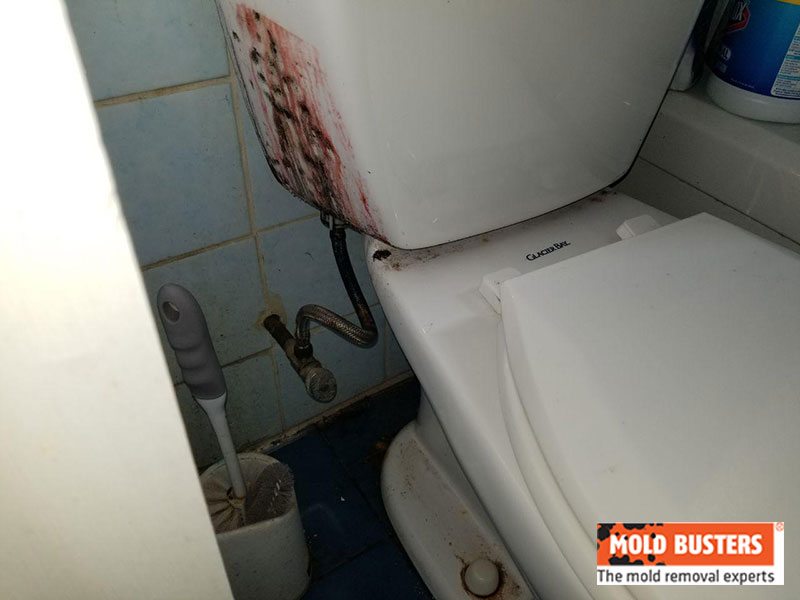
When autumn and cold weather comes, these cells aggregate and eventually form a plasmodium – one of the two macroscopic structures (Fig. 7). In this form, slime mold spreads over a surface, much like a regular mold does, and starts feeding. However, unlike fungal molds which permeate the substrate and extract nutrients, slime molds feed on organic matter, bacteria, protists, other molds, and even higher fungi that are found on the substrate surface (14,15). These substrates can be leaves, soil, logs, and even wood elements in our homes.
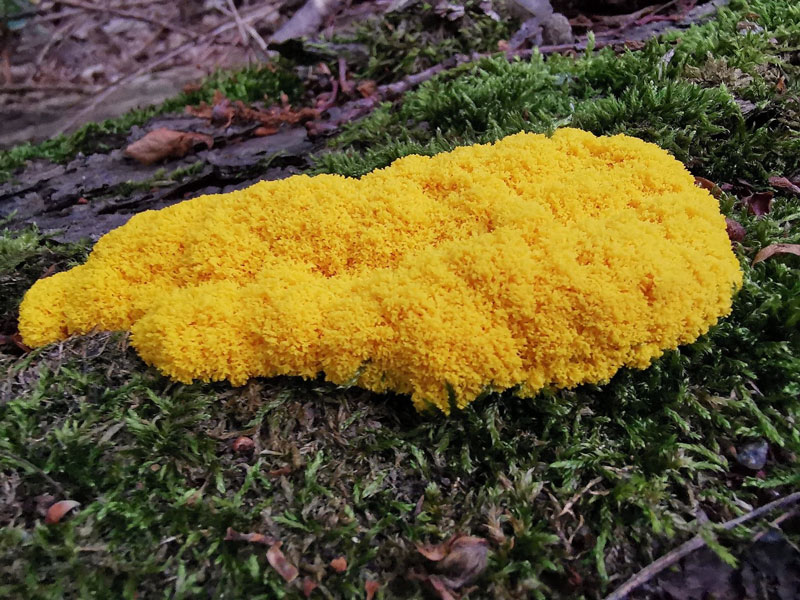
Just before the winter freeze, plasmodia will stop feeding and start forming sporocarps – spore-bearing structures. In this form, the organism will start to resemble the slime mold that we most often recognize. The body of the slime molds will dry out and harden over winter until the spring snow thawing, winds and participation release the spores and the entire cycle will start again (14,15). Some of the more common slime molds that can appear orange are Fuligo septica, Tubifera ferruginosa, species from the Trichia genus. Physarum polycephalum can also appear orange when old.

Myxomycetes are not classified as human pathogens like regular molds because, although they look similar and share similar habitats and lifestyles, they have different biology. However, even though slime molds feed on bacteria and other microorganisms in nature, they can grow in liquid cultures, nutrient agar plates, and importantly – on nutrient-moistened surfaces (16). This is one of the reasons how we can have slime mold contaminations in our homes. Though not invasive pathogens, studies have shown that or bodies react to slime mold spores as allergens. It was demonstrated that 40% of subjects who suffer from seasonal allergic rhinitis had positive skin test reactions to slime mold spores (16). Furthermore, statistics show that slime molds can make up to 25% of mold presence in our homes (Fig. 9).
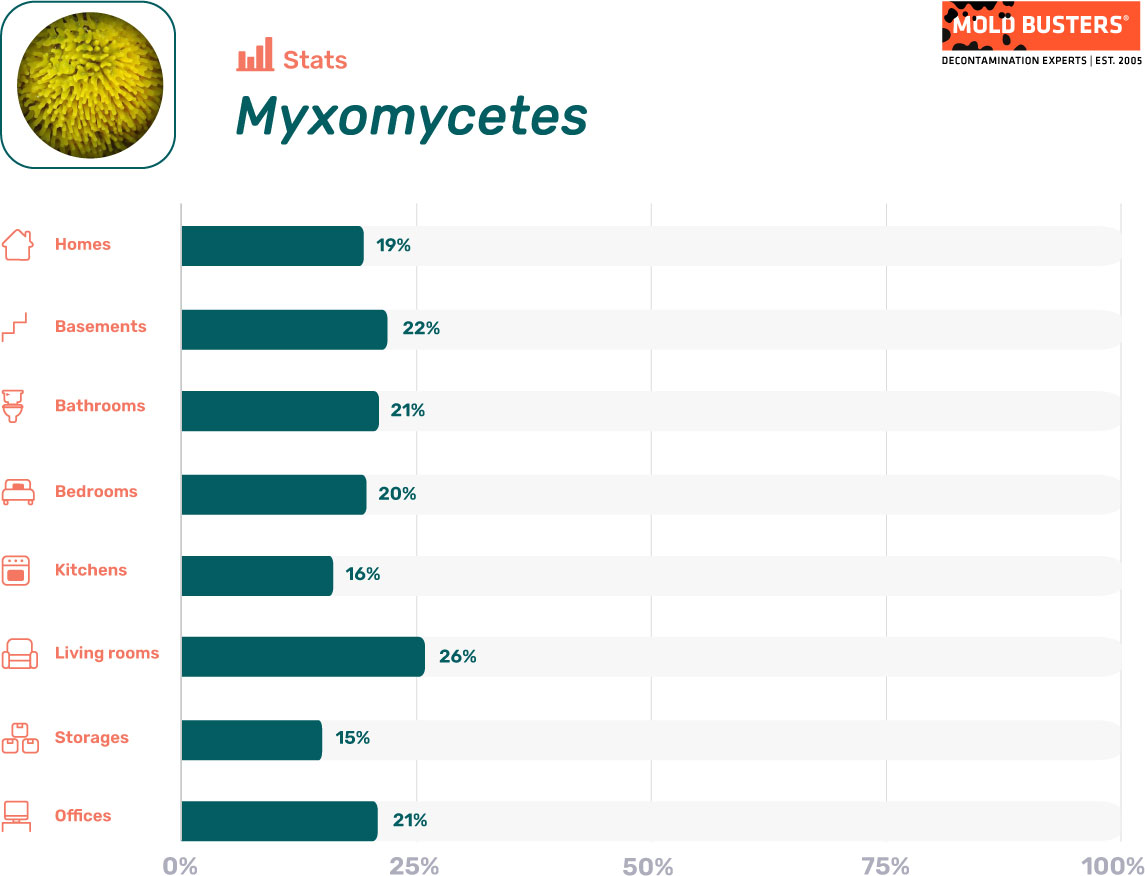
What causes orange mold?
As with all other types of mold, orange mold grows wherever there is moisture, heat and a food source. However, orange mold differs from other types because it is more likely to grow on wood than other organic materials.
Knowing this, you should be especially vigilant about orange mold growth in areas of your home with high humidity and lots of wood.
Where can orange mold appear?
Wooden window sills are magnets for orange mold, as well as exposed structural beams in basements. Attics are also havens for orange mold growth because they collect warm air and moisture that rises from the rest of the house and they usually have exposed rafters. If you’re in Montreal or Ottawa, our team can help you identify and address these issues.
Finally, your kitchen is a hotbed for orange mold growth; wood in the floor and especially in the ceiling above the stove are vulnerable to orange mold growth.
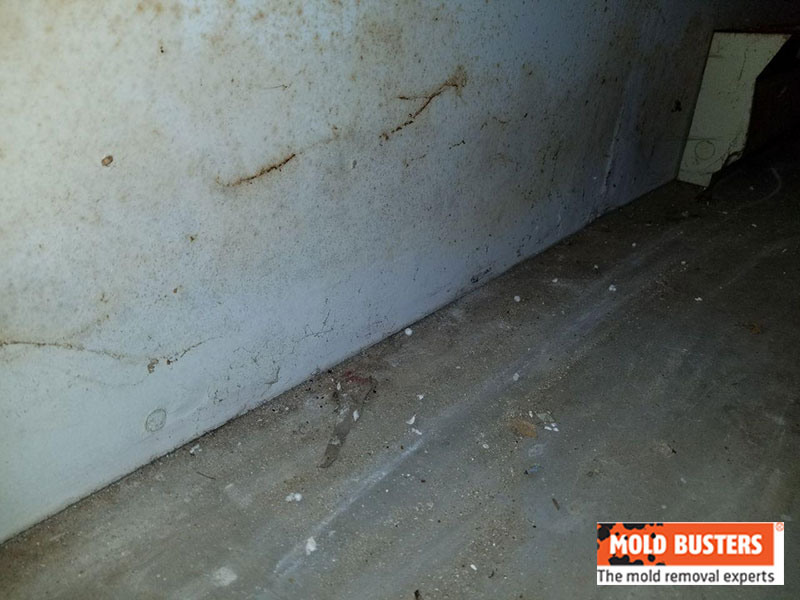
What are the health risks of orange mold?
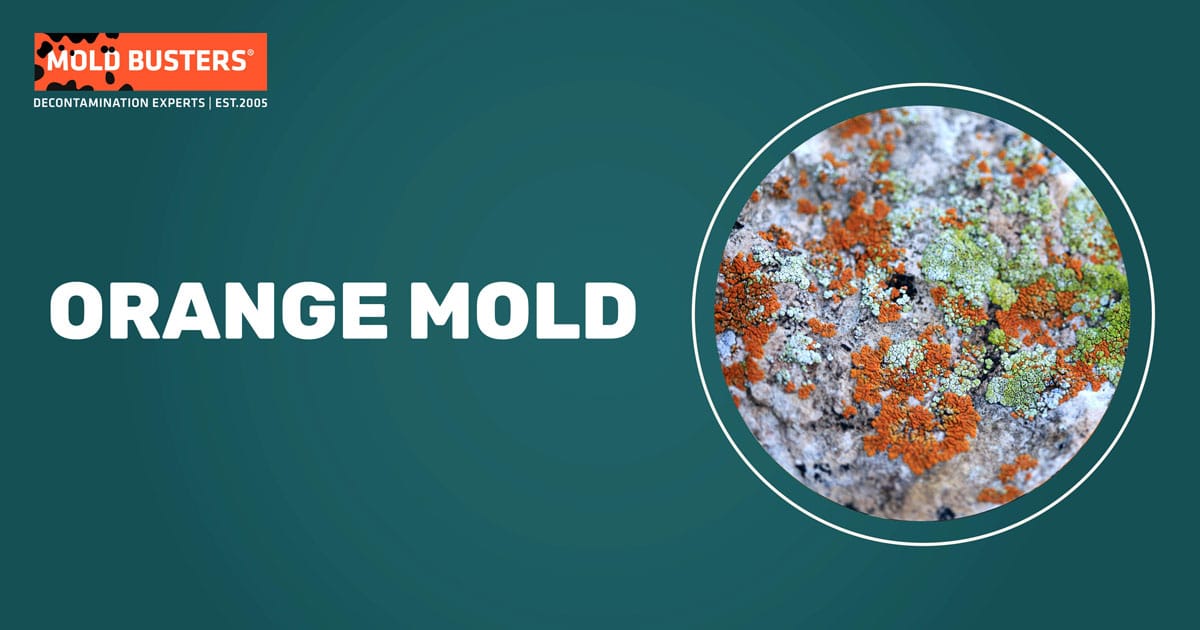
You may have heard certain molds associated with certain diseases (e.g., black mold and cancer), but contrary to popular belief, mold doesn’t affect everyone the same way.
Some people are allergic to mold and may experience symptoms ranging from congestion and itchiness to full-blown anaphylactic shock. Others may experience mild symptoms like headaches, while others can be made seriously ill with cancer or even neurological disorders.
The health risks of mold exposure for a particular individual will depend on four factors:
- The type of mold: Not all species of mold are harmful to humans, and yet others can be fatal with minimal exposure. Many species with vastly different health risks present with the same colour and even consistency, so species of mold can’t be identified with any kind of certainty upon visual inspection. If you notice mold in your home, you should have a sample collected by qualified mold professionals for testing at a third-party laboratory.
- The severity of infestation: A few mold spots around your windowsill won’t cause much harm, but a mold infestation covering more than a few square feet can cause serious illness. However, it is important not to estimate the severity of infestation based solely on what you see. Mold often hides in walls, attics and floors, meaning that the mold you see is just the tip of the iceberg. If you think your home may be infested with mold, you should have it inspected by certified mold expert, who can use sophisticated equipment and techniques (e.g., air testing, infrared scanning) to determine just how much mold is growing in your home.
- The length of exposure: As with any harmful pathogen, the health risks of mold will vary depending on how long you are exposed to it. A few hours in a moldy house likely won’t cause serious problems, whereas spending several hours a day for years in a moldy house can be extremely detrimental to your health. The only way to be sure that you are not suffering from long-term exposure is to have your home’s air quality tested by a reputable mold testing company.
- The health of the people being exposed: People with weakened immune systems—such as children, the elderly and people already suffering from serious illnesses—will be more susceptible to mold-related illnesses. In the case of toxic mold, children are more vulnerable because their bodies are smaller and their immune systems are not yet fully developed. They will therefore suffer toxic reactions to mold at lower doses. If you or anyone in your household suffers from allergies or a suppressed immune system, you should have your home inspected by qualified mold professionals. An inspection may uncover a serious hidden mold problem and, even if it doesn’t, you’ll have peace of mind!
How can you get rid of orange mold?
If you notice small mold colonies in your home, you can usually tackle them yourself using proper equipment and procedures. However, if you’re unsure, we offer a virtual inspection service to help you assess the situation.
Before removing mold on your own, wear a respirator and protective gloves. This will prevent you from inhaling harmful mold spores and from developing any rashes on your skin from topical contact with mold.
Once you have protective equipment, wipe the affected area with a bleach or vinegar solution, leave it to soak (this gives the solution time to kill the mold), then wipe it away. Spray the area again to get any residual mold spores and leave it to dry.
Keep in mind that this DIY mold removal solution is effective only for surface mold growth, namely if the contaminated material is non-porous. If the material is porous (wood, drywall, etc.), it will likely require more in-depth cleaning.
If a mold infestation is larger than one square metre, Health Canada recommends that you hire reputable and experienced mold remediation professionals to remove the mold.
If you attempt to clean a mold infestation of this size yourself, you’ll likely make the problem worse by spreading spores to other areas of the home. You could also make yourself sick through exposure to massive amounts of mold.
Professional mold remediation is a good opportunity to have the cause of the mold infestation diagnosed so you can understand what caused the mold to grow in the first place in order to prevent it from growing back.
References
- Sharma, A., Hazarika, N. K., Barua, P., Shivaprakash, M. R., & Chakrabarti, A. (2013). Acremonium strictum: report of a rare emerging agent of cutaneous hyalohyphomycosis with review of literatures. Mycopathologia, 176(5), 435-441.
- Fakharian, A., Dorudinia, A., Darazam, I. A., Mansouri, D., & Masjedi, M. R. (2015). Acremonium pneumonia: case report and literature review. Tanaffos, 14(2), 156.
- Perdomo, H., Sutton, D. A., García, D., Fothergill, A. W., Cano, J., Gené, J., … & Guarro, J. (2011). Spectrum of clinically relevant Acremonium species in the United States. Journal of Clinical Microbiology, 49(1), 243-256.
- Epicoccum purpurascens | Mould Compendium | INSPQ [Internet]. [cited 2021 Oct 31]. Available from: inspq.qc.ca
- Fávaro, L. C. D. L., Sebastianes, F. L. D. S., & Araújo, W. L. (2012). Epicoccum nigrum P16, a sugarcane endophyte, produces antifungal compounds and induces root growth. PloS one, 7(6), e36826.
- Qian, Y., Yu, H., He, D., Yang, H., Wang, W., Wan, X., & Wang, L. (2013). Biosynthesis of silver nanoparticles by the endophytic fungus Epicoccum nigrum and their activity against pathogenic fungi. Bioprocess and biosystems engineering, 36(11), 1613-1619.
- Larena, I., Torres, R., De Cal, A., Liñán, M., Melgarejo, P., Domenichini, P., … & Usall, J. (2005). Biological control of postharvest brown rot (Monilinia spp.) of peaches by field applications of Epicoccum nigrum. Biological Control, 32(2), 305-310.
- Hameed, A. A., Yasser, I. H., & Khoder, I. M. (2004). Indoor air quality during renovation actions: a case study. Journal of Environmental Monitoring, 6(9), 740-744.
- Dixit, A. B., Lewis, W. H., & Wedner, H. J. (1992). The allergens of Epicoccum nigrum link: I. Identification of the allergens by immunoblotting. Journal of allergy and clinical immunology, 90(1), 11-20.
- Bisht, V., Singh, B., Kumar, R., Arora, N., & Sridhara, S. (2002). Culture filtrate antigens and allergens of Epicoccum nigrum cultivated in modified semi-synthetic medium. Medical microbiology and immunology, 191(1), 11-15.
- Hogan, M. B., Patterson, R., Pore, R. S., Corder, W. T., & Wilson, N. W. (1996). Basement shower hypersensitivity pneumonitis secondary to Epicoccum nigrum. Chest, 110(3), 854-856.
- Pitt, J. I., & Hocking, A. D. (2009). The ecology of fungal food spoilage. In Fungi and food spoilage(pp. 3-9). Springer, Boston, MA.
- Baldauf, S. L., & Doolittle, W. F. (1997). Origin and evolution of the slime molds (Mycetozoa). Proceedings of the National Academy of Sciences, 94(22), 12007-12012.
- Introduction to the “Slime Molds” [Internet]. [cited 2021 Oct 31]. Available from: berkeley.edu
- Bonner, J. T., & Lamont, D. S. (2005). Behavior of cellular slime molds in the soil. Mycologia, 97(1), 178-184.
- Lierl, M. B. (2013). Myxomycete (slime mold) spores: unrecognized aeroallergens?. Annals of Allergy, Asthma & Immunology, 111(6), 537-541.

Get Special Gift: Industry-Standard Mold Removal Guidelines
Download the industry-standard guidelines that Mold Busters use in their own mold removal services, including news, tips and special offers:
"*" indicates required fields
Published: February 20, 2019 Updated: May 24, 2024

Written by:
Dusan Sadikovic
Mycologist - MSc, PhD
Mold Busters
Fact checked by:
Michael Golubev
CEO
Mold Busters
